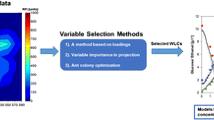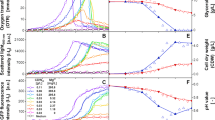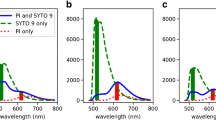Abstract
Fluorescence spectroscopy is a non-invasive and highly sensitive method for bioprocess monitoring. The use of fluorescence spectroscopy is not very well established in the industry for in-line monitoring. In the present work, a 2-D fluorometer with two excitation lights (365 and 405 nm) and emission spectra in the range of 350–850 nm were used for in-line monitoring of two strains of Bordetella pertussis cultivation operated in batch and fed batch. A Partial Least Squares (PLS) based regression model was used for the estimation of cell biomass, amino acids (glutamate and proline) and antigen (Pertactin) produced. It was observed that accurate predictions were achieved when models were calibrated separately for each cell strain and nutrient media formulation. Also, prediction accuracy was improved when dissolved oxygen, agitation and culture volume are added as additional features in the regression model. The proposed approach of combining in-line fluorescence and other online measurements is shown to have good potential for in-line monitoring of bioprocesses.






Similar content being viewed by others
Data availability
The dataset generated and/or analyzed during the current study are available from the corresponding author upon reasonable request.
References
Agarwal P, Tamer M, Budman H (2021) Explainability: relevance based dynamic deep learning algorithm for fault detection and diagnosis in chemical processes. Comput Chem Eng 154:107467
Agarwal P, Tamer M, Sahraei MH, Budman H (2019) Deep learning for classification of profit-based operating regions in industrial processes. Ind Eng Chem Res 59(6):2378–2395
Mandenius C-F, Titchener-Hooker NJ et al (2013) Measurement, monitoring, modelling and control of bioprocesses, vol 132. Springer
Korshin GV, Li C-W, Benjamin MM (1997) Monitoring the properties of natural organic matter through UV spectroscopy: a consistent theory. Water Res 31(7):1787–1795
Kara S, Mueller J, Liese A (2011) Online analysis methods for monitoring of bioprocesses. Chim Oggi 29:38–41
Long DA (1977) Raman spectroscopy. New York 1
Royer CA (1995) Fluorescence spectroscopy. Protein Stabil Fold 65–89
Wold S, Esbensen K, Geladi P (1987) Principal component analysis. Chemom Intell Lab Syst 2(1–3):37–52
Höskuldsson A (1988) Pls regression methods. J Chemometrics 2(3):211–228
Braspenning PJ, Thuijsman F, Weijters AJMM (1995) Artificial neural networks: an introduction to ANN theory and practice, vol 931. Springer Science & Business Media
Yi L et al (2016) Chemometric methods in data processing of mass spectrometry-based metabolomics: a review. Anal Chim Acta 914:17–34
Abbas O, Pissard A, Baeten V (2020) In near-infrared, mid-infrared, and Raman spectroscopy. Elsevier, pp 77–134
Haas J, Mizaikoff B (2016) Advances in mid-infrared spectroscopy for chemical analysis. Annu Rev Anal Chem 9:45–68
Fazenda ML et al (2013) Towards better understanding of an industrial cell factory: investigating the feasibility of real-time metabolic flux analysis in pichia pastoris. Microb Cell Fact 12(1):1–14
Graves P, Gardiner D (1989) Practical Raman spectroscopy. Springer
Shaw AD et al (1999) Noninvasive, on-line monitoring of the biotransformation by yeast of glucose to ethanol using dispersive Raman spectroscopy and chemometrics. Appl Spectrosc 53(11):1419–1428
Faassen SM, Hitzmann B (2015) Fluorescence spectroscopy and chemometric modeling for bioprocess monitoring. Sensors 15(5):10271–10291
Ödman P, Johansen CL, Olsson L, Gernaey KV, Lantz AE (2010) Sensor combination and chemometric variable selection for online monitoring of streptomyces coelicolor fed-batch cultivations. Appl Microbiol Biotechnol 86(6):1745–1759
Teixeira AP et al (2009) In situ 2d fluorometry and chemometric monitoring of mammalian cell cultures. Biotechnol Bioeng 102(4):1098–1106
Teixeira AP, Duarte TM, Carrondo M, Alves PM (2011) Synchronous fluorescence spectroscopy as a novel tool to enable pat applications in bioprocesses. Biotechnol Bioeng 108(8):1852–1861
Graf A, Claßen J, Solle D, Hitzmann B, Rebner K, Hoehse M (2019) A novel led-based 2d-fluorescence spectroscopy system for in-line monitoring of Chinese hamster ovary cell cultivations-part I. Eng Life Sci 19(5):352–362
Karakach TK, Dachon A, Choi J, Miguez C, Masson M, Tartakovsky B (2019) Fluorescence-based real time monitoring and diagnostics of recombinant Pichia pastoris cultivations in a bioreactor. Biotechnol Prog 35(2):e2761
Hu S (2007) Akaike information criterion. Center Res Sci Comput 93:42
Cavanaugh JE, Neath AA (2019) The Akaike information criterion: background, derivation, properties, application, interpretation, and refinements. Wiley Interdisciplinary Rev 11(3):e1460
Proom H, Knight B (1955) The minimal nutritional requirements of some species in the genus bacillus. Microbiology 13(3):474–480
Blacker TS, Duchen MR (2016) Investigating mitochondrial redox state using nadh and nadph autofluorescence. Free Radical Biol Med 100:53–65
Ashoori M, Saedisomeolia A (2014) Riboflavin (vitamin b2) and oxidative stress: a review. Br J Nutr 111(11):1985–1991
Wellen KE, Thompson CB (2010) Cellular metabolic stress: considering how cells respond to nutrient excess. Mol Cell 40(2):323–332
Acknowledgements
This work was financially supported by Sanofi and Mitacs (IT6479). We are also immensely thankful to Dr. Boris Tartakovsky (National Research Council, Montreal) for his support.
Author information
Authors and Affiliations
Corresponding author
Ethics declarations
Conflict of Interest
Melih Tamer is a Sanofi employee and may hold shares and/or stock options in the company.
Additional information
Publisher's Note
Springer Nature remains neutral with regard to jurisdictional claims in published maps and institutional affiliations.
Rights and permissions
Springer Nature or its licensor (e.g. a society or other partner) holds exclusive rights to this article under a publishing agreement with the author(s) or other rightsholder(s); author self-archiving of the accepted manuscript version of this article is solely governed by the terms of such publishing agreement and applicable law.
About this article
Cite this article
Mishra, A., Tamer, M. & Budman, H. In-line monitoring of Bordetella pertussis cultivation using fluorescence spectroscopy. Bioprocess Biosyst Eng 46, 789–802 (2023). https://doi.org/10.1007/s00449-023-02857-6
Received:
Accepted:
Published:
Issue Date:
DOI: https://doi.org/10.1007/s00449-023-02857-6




